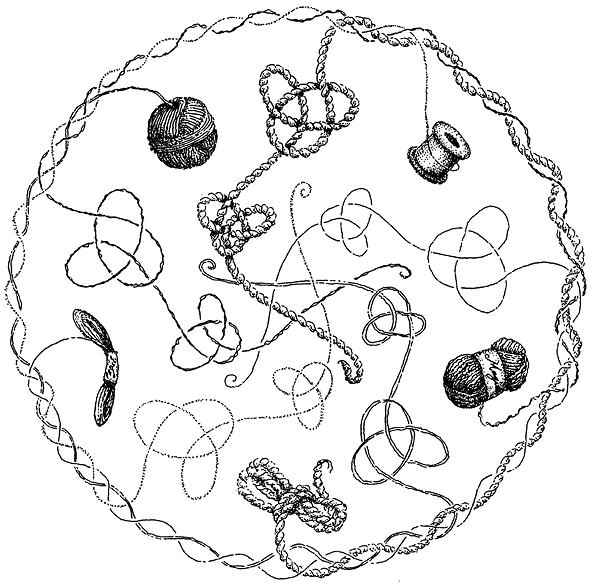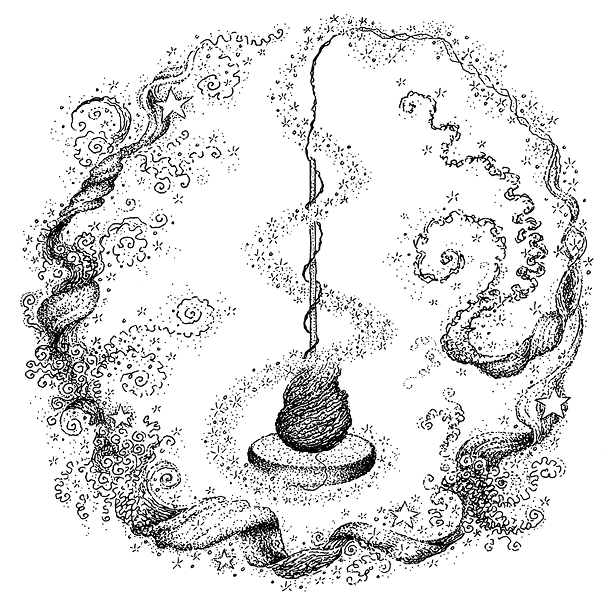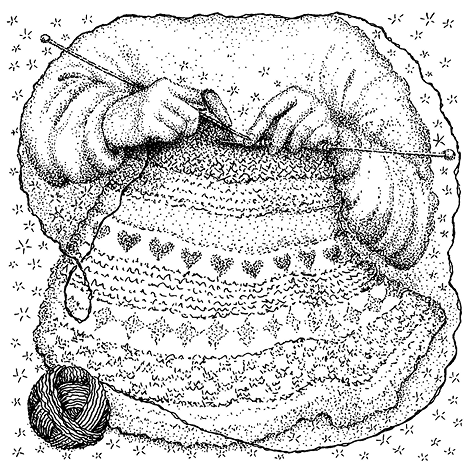
Cord magic spans a wide range of things you can do with fibercrafts and mystical energy. It is one of the oldest types of magic: the earliest concrete evidence of cordmaking dates back around 90,000 years, and indirect evidence suggests it could reach back over two million. Among the most famous applications are binding and containment spells. However, many more possibilities exist depending on how and what materials are used.
Thread, String, and Rope
“Cord” can refer to any strand of twisted fibers. Twisting them together makes a stronger line that stays put and holds other things in place. To make a thicker diameter, several pieces may be twined together in such configurations as two-ply or three-ply rope. Other times a sheath may be woven around a central bundle of cords. Embroidery floss is designed to come apart so that you may decide how many strands to use at once.
The size of the cord influences what you can do with it. Thread is fine and smooth. It can’t hold much weight but it is very discreet; you can stitch or tie a charm that will be unnoticeable from a few steps away. String offers a great balance between something that is lightweight yet fairly strong. It’s easy to carry string with you for emergency magical needs. Thread and yarn may be knitted, crocheted, woven, or made into fabric. Rope is very sturdy and lasts a long time. It also provides a visual signal, such as knots on a boundary marker, when you want people to see what you’re doing or during a group ritual.
Generally, use the thinnest cord that will do the job. It’s less bulky and expensive that way. Choose the size based on what it needs to do. If you want it to flex or lie smooth, thinner is better. Thread is usually the only size to disappear well. If it needs to hold weight, thicker is better. For knots, string and rope let you see more clearly what you’re doing.
Materials
Cord comes in many types. Common fibers include cotton, linen, wool, and silk. Rope adds some coarser options, such as jute and hemp, but those require careful handling because they are prickly. For most magical purposes, you want natural fibers like these. They tend to work well with magic, although silk is notable as a magic insulator. Synthetic fibers include acrylic, nylon, and polyester. These work best for technomagic and tend to insulate against natural magic. As with most types of artifact crafting, use the best materials you can get, preferably new rather than reused. If you use inferior materials, the magic will burn through them quickly, causing the fibers to fall apart. Here are some materials, their positive and negative qualities, and any notes on magical function:
Acrylic: Dyes brightly and stays colorfast, lightweight yet bulky, luxurious feel, good draping, resistant to odors and mildew, good insulation, excellent moisture management. Can stretch and shrink, forms static electricity, pills easily, breaks down under extreme heat.
Cotton: Breathable, soft yet durable, versatile, hypoallergenic. Dyes tolerably well but not colorfast, shrinks, wrinkles, mildew prone. (Woven cotton rope such as a clothesline is good for tying and untying knots, but after wetting, it’s harder to untie.)
Hemp: Strong, hypoallergenic, eco-friendly, breathable, resistant to ultraviolet light. Can be scratchy, dyes with dull colors and not colorfast, wrinkles. (Best choice for imaginative or psychedelic work.)
Jute: Cheap, eco-friendly, strong, breathable, antistatic. Brittle, sheds fibers, scratchy, drapes poorly, weak when wet, dyes poorly, is prone to microbial decay.
Linen: Strong, stronger when wet, withstands high temperatures, antistatic, no pilling or lint. Wrinkles, not very durable, drapes poorly, low elasticity, expensive.
Nylon: Dyes easily, cleans easily, strong, resilient, abrasion resistant. Stains easily, fades in sunlight, too slippery to knot.
Polyester: Dyes easily, colorfast, strong, shiny, lightweight, does not shrink or stretch, mildew resistant. Does not breathe, eco-hostile, stains easily, stiff, holds knots poorly but better than nylon.
Silk: Dyes beautifully, nonallergenic, soft, shiny, luxurious, breathable, durable, makes secure knots, lightweight. Stains easily, needs special care, tangles, very expensive. (Insulates against magic.)
Wool: Dyes well, strong and warm (even more so when wet), breathable, tear resistant, elastic, luxurious. Colors tend to be dull, deteriorates in sunlight, pills easily, itchy, vulnerable to mold and mildew. (Best choice for animal magic.)

Colors
Most types of cord can be dyed in desired hues. Wool grows naturally in a range of black, brown, gray, white, and reddish tones. By choosing an appropriate color, you can add energy and make sure the cord resonates with its intended purpose. Here are some colors and their correspondences:
White: purification, positive energy, unity, consecration, general purpose, youth
Gray: balance, moderation, contemplation, diffusion, technology
Black: binding, negative energy, concealment, wisdom, protection, reversing
Brown: nourishing, grounding, animals, stability, body, earth
Gold: eternity, unchanging, masculine energy, the Sun, the God
Silver: rebirth, cycles, feminine energy, the Moon, the Goddess
Pink: friendship, affection, platonic love, emotional healing
Red: passionate love, intense energy, fire, life force, adulthood
Orange: creativity, self-expression, ambition, vigor, travel
Yellow: joy, communication, uplifting, new beginnings, air
Green: nature, plants, healing, prosperity, luck, abundance
Blue: soothing, sleep, dreams, justice, willpower, focus, truth, mind, water
Violet: magic, psychic power, divine connection, endings, spirit, elders
Spinning and Braiding
In order to work cord magic, first you need the cord. Spinning, in which you twist fibers into a long spiral, is the most popular way of creating it. Some fibers can also be braided, or you can spin cords and then braid them. Use the cords for hanging things, tying knots, or other purposes.
Spinning channels power through a spiral motion. It can be done slowly with a hook, faster with a drop-spindle, or quite briskly with a spinning wheel. Most cord today is spun by machine, and it works fine for magic. However, for maximum impact, you can make your own. Use fiber with good “catch,” such as wool, so that it spins easily.
Braiding crosses strands so they stay together. You can make use of number magic as you combine three or more strands. Make a solid-colored braid, or choose colors to represent the different energies. A three-strand braid might feature maiden, mother, and crone. A four-strand braid might use earth, air, fire, and water. Among the simplest cord magic spells is making a braid while holding your intent in mind.
Knotting
Knots can be used to capture energy. Some have a specific theme, such as the “true love” knot. Many spells are done with a plain overhand knot. One of the oldest spells recorded is for sailors. They would take a rope outside during a strong wind and tie knots in it to bind that power. When a ship was becalmed at sea, they would untie one or more of the knots to raise wind for traveling.
Knots are also used to secure the loose end at the conclusion of many fibercrafts such as braiding. Note that once you make the final knot, it seals the magic in place. If you cut that knot off, the magic will run out. This is actually useful: if you make a mistake in the magic, you can cut it loose, and still salvage the mundane craft. Just make a new knot to keep the work from unraveling.
Celtic knotwork represents infinity and connections. It may use plain lines or shape them into animals and people. This type of knotwork uses cords to make handles, pendants, bracelets, and other items. It’s also beautiful when the cords are knotted and stitched onto pillows or quilts. Different images may evoke the Triple Goddess, the Horned God, the White Stag, or other mythic figures.
Latch hook is a simple craft that involves knotting short yarns around a canvas base to create a patterned rug. This pairs well with a mantra or chant, which you repeat each time you tie a knot. That repetition adds power, like filling a pool one bucket at a time. It works great for making coven rugs with magical designs, such as a pentacle.
A good knot spell is to visualize something upsetting you, then tie an overhand knot in a black cord. Put all your negative feelings into that knot. Yell at it or stomp on it if you wish. Then go soothe yourself with a bath, a hot meal, or whatever helps you relax. Later come back and untie the knot to release the energy, and it will help you work through the problem.
Knitting and Crochet
These types of fibercraft rely on making yarn into a great big sheet of knots by using a tool. The tools, whether knitting needles or crochet hooks, can help you tune the magic if they are made out of wood or metal, and you can use the correspondences for that material as well as the yarn itself. For technomagic, you might prefer aluminum or plastic. Think of this as your magic wand, and speak the incantation as you work.
Next, consider the shape. You can work in a spiral, a triangle, squares, rows, and so forth. There are even pentagram patterns! This works well for flat objects such as altar cloths, rugs, afghans, etc. You can work in positive energy for things like warming or comforting spells. It’s also possible to knit or crochet pieces that are later fastened together to make stuffed animals, fitted garments, and other projects.

You can even use the wand motion as your primary casting and the yarn as a disguise. This works for such things as banishing or shielding in a public place, where you want people to respect your space. Point the tip of your wand at them and imagine flicking them away. When you finish your project, you’ll also have a scarf or whatever that is good for the same shielding or banishing.
Weaving
Woven fabric typically has warp (lengthwise threads) and weft (woven around the warp threads), although finger-weaving uses the same strands for both purposes in a diagonal pattern. When you weave, you can easily switch colors to make pictures or other patterns. “Shot silk” uses warp of one color and weft of a contrasting color, so that the fabric seems to change tones as it moves, perfect for working magic with fire and water (red and blue) or earth and air (brown and yellow).
If you’re weaving a rug, stole, altar cloth, or other strip design, then you also have the option of using knots. Gather the warp threads together in small bundles, focus your intent, and then tie the knot. Say a mantra over each one as you do so. In this manner you may anchor many little parts of a spell as you work your way across the two raw ends of the cloth.
Conclusion
Cord magic is really based in hearth magic, something you do as you make it, rather than a quick spell with premade components. It’s an everyday application of mystical energy that you can use to make your life easier or just a little more enchanted. You can pick and choose the type of materials, size of cord, and finished project based on your needs.
Bear in mind that fibercraft is a kind of moving meditation, and cord magic of all kinds requires sustained focus. In mundane crafts, you can let your thoughts wander; in magic, you must keep the purpose in mind while you are working. Therefore, start with small projects to build up your stamina; you might start with a potholder charmed against burning or dropping. Later, break large projects into specific stages with good stopping points to anchor the energies temporarily. A quilt might be made one square at a time, each with a different well-wishing on it. Some people find that it helps to play suitable music or nature sounds to help maintain their concentration on the theme.
Look around your sacred space to see what kind of magical items you could make with thread, yarn, or rope. Choose something and give it a try!